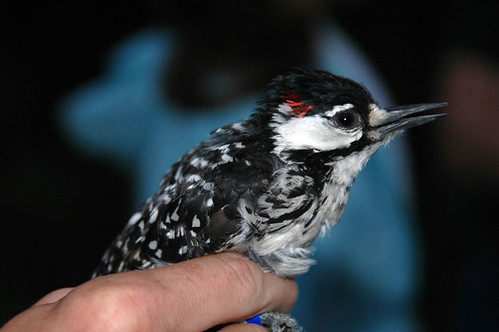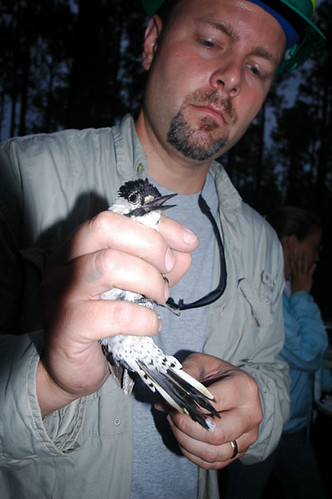
A Forest Service employee monitors a red-cockaded woodpecker to track population trends and to identify birds that may be moved to other populations as part of the species’ translocation program. Photo credit: U.S. Forest Service/Chuck Hess
It isn’t often that an endangered species successfully recovers, which is why the story of the red-cockaded woodpecker is so inspiring.
Once found throughout 90 million acres of longleaf pine forests in the southeast, the red-cockaded woodpecker’s population on National Forest System lands today number approximately 3,150 active clusters of typically one to five birds each. This is a 60 percent increase from the low of 1,981 active clusters in 1990.
The biggest threat to this rare woodpecker’s existence today is the lack of suitable habitat, but theApalachicola National Forest provides a safe refuge for its largest population in the world.

Wildlife Biologist John Dunlap of the Apalachicola National Forest examines a red-cockaded woodpecker, which nests in the forest’s longleaf pine ecosystem. These woodpeckers are effective indicators of a healthy longleaf pine ecosystem. Photo credit: U.S. Forest Service/Susan Blake
John Dunlap, a Forest Service wildlife biologist on the Apalachicola is one of many biologists contributing to recovery efforts. According to Dunlap, the most critical component of habitat management is fire. The red-cockaded woodpecker evolved in a landscape that burned at two- to three-year intervals. In a pine forest, fire will keep hardwoods to a minimum and promote a grassy ground cover typical of a high-quality longleaf pine forest where many rare species can flourish.
“The most exciting thing in recent years has been the growth of the Wakulla Ranger District population. In the spring of 2005 there were 106 active clusters in this population. We are currently crunching the numbers for the spring 2015 season and we have our fingers crossed that we will hit 200,” said Dunlap.
When the surveys were completed, Apalachicola National Forest staff found 203 active red-cockaded clusters in 2015, marking another population milestone.
This fall, there are plans to relocate 15 pairs through the Southern Range Translocation Cooperative, with as many as five additional pairs being moved from the Apalachicola Ranger District population over to the Wakulla Ranger District.
The red-cockaded woodpecker has come a long way since it was listed as an endangered species in 1970.
“Although the RCW is still listed as endangered, this bird is a true success story,” said Dunlap. It seems the efforts of the Apalachicola National Forest to bring the species back have been incredibly successful.

Wildlife biologists band red-cockaded woodpeckers on the Apalachicola and Osceola national forests to monitor their nesting activities and population health on each forest. Photo credit: U.S. Forest Service/Susan Blake
No comments:
Post a Comment
Note: Only a member of this blog may post a comment.